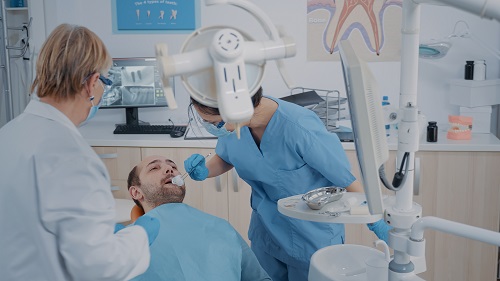
Turuncu Dental Clinic - Antalya - Turkey
It is the process of removing decayed or damaged teeth that cannot be saved by dentists and oral, dental and maxillofacial surgeons with treatment (even if filling, root canal treatment or crown operation is performed) from the bone socket.

Tooth extraction is a very safe medical practice as long as it is done in hygienic environments in the right hands. In a low probability, tooth extraction can lead to the entry of harmful bacteria into the circulatory system. Since the gingival tissue is damaged with extraction, there is a risk of infection. If the patient is likely to develop a severe infection for a different medical reason, the patient may need to use antibiotics before and after tooth extraction. For this reason, it is important for the patient to share their medical history with the dentist before tooth extraction.
The patient should definitely inform the dentist about his chronic diseases, regular medications, existing heart conditions, damaged or artificial heart valve, congenital heart defect, impaired immune system, liver disease (cirrhosis), and bacterial endocarditis before the procedure.
Tooth extraction performed by dentists and oral surgeons is one of the types of outpatient treatment. The tooth extraction process is as follows:
Tooth extraction is a simple procedure that is often performed with local anesthesia. Surgical tooth extraction is applied chiefly during the extraction of impacted wisdom teeth. Although it is mainly performed under local anesthesia, there are cases where general anesthesia is applied.

The teeth to be extracted are separated part by part. The extraction process is done accordingly.
Dentist recommendations should be followed after tooth extraction. Otherwise, you may encounter complications such as inflammation after tooth extraction, pain when the mouth is opened and closed, and swelling after tooth extraction. Your recovery time may be longer due to the tooth infection you have experienced.
How many days will the extracted tooth heal? How many hours to eat after tooth extraction? What is the whiteness that occurs after tooth extraction?” Our experienced dentists will answer all your questions. He will also explain in detail what you need to do after tooth extraction.
After standard tooth extraction, no problem is observed except for mild pain that will be controlled with painkillers. Depending on the difficulty of the tooth extraction process, the complaints will pass within a few days.
Teeth and tongue should be brushed, and floss should be used to protect oral health and hygiene without damaging the part where the tooth extraction is made. In the brushing process, the mouth should be spit slightly after rinsing. The environment that may cause infection should be cleaned by providing oral hygiene.
In patients who take into account the dentist's recommendations, there is no problem after the extraction or the problem is resolved quickly. However, an infection may occur when the patient does not follow the doctor's recommendations; Various problems and pains can be experienced. In these cases, the duration of treatment is prolonged, and the patient's quality of life decreases.
If excessive bleeding or severe pain persists for more than four hours after a tooth extraction, call your dentist immediately and report your situation to your physician.
Symptoms of infection include pain after tooth extraction, fever and chills seen from time to time, redness, swelling, cough, shortness of breath, chest pain, nausea, and vomiting in the extraction area. Patients experiencing these complaints should also apply to the dentist without wasting time.
Tooth extraction prices vary depending on whether surgical tooth extraction is needed for tooth extraction, the number of teeth to be extracted, the structure of the tooth, whether the tooth is impacted or not, the experience of the dentist, and the location of the dental clinic. For detailed information, we recommend you come to our clinic and be examined.
While the first healing after a tooth extraction is in a few days, it takes a week or two for the tissues to heal fully. During this time, new jawbone and gingiva form and grow in the cavity opened after tooth extraction. Extraction of one tooth can sometimes cause other teeth to slip. In this case, biting, which is ideal for the patient, causes a lack of chewing. To prevent this, your dentist may recommend treatments such as implants and fixed prosthetic bridges.
While surgical tooth extraction takes about 40-60 minutes, tooth extractions that do not require surgery take 15-20 minutes. Extraction of wisdom teeth, which are not embedded, takes up to 30 minutes.
Since the tooth extraction is performed while the patient is under local or general anesthesia, there is no pain during the extraction. It is normal to feel some pain after the numbness has passed. This pain can be controlled with painkillers prescribed by your doctor.
There is no limit to the number of teeth extracted in one go.
Broken tooth extraction is a straightforward procedure that can be done in minutes with local anesthesia and qualified specialist physicians.
Follow your dentist's recommendations, and pay attention to your oral hygiene and gargle. With attentive care, scar tissue can heal in 1 week.
If the tooth that needs to be extracted is decayed or infected, It can cause damage to other teeth as well. It causes pain and a bad smell. It causes swelling and pain in the face and jaw.
Caries in milk teeth should be treated immediately. Otherwise the gap created by the milk teeth that had to be extracted causes crowding in the newly erupted teeth.
What happens if the impacted tooth is not extracted: the tooth that cannot pass through the gum tissue and cannot come out often abscesses, swells, and causes pain in the jaw. In cases where there is not enough forehead in the jaw to come out, the impacted tooth causes disturbances in the tooth alignment as it presses on the other teeth. It may require orthodontic treatment to correct the misalignment. The impacted wisdom tooth can cause nutrient accumulation. This can lead to decay of other teeth.
If there is severe bleeding in the part of the tooth extraction, if the bleeding does not stop despite changing 3 tampons, contact your doctor.
Throw away the spare 3rd tampon given to you after the shooting, after biting it for 30 minutes. Swallow any light bleeding that occurs after this time. Don't spit. Spitting can start bleeding again and again violently.
The treatment is done by considering the fracture rate and fracture type of the tooth. The filling can be done to a half-broken tooth. The broken part of the tooth can be fixed with special adhesives. If the fracture is close to the root, root canal treatment and veneers can be performed, or if the tooth cannot be saved, tooth extraction is performed.
It is normal to feel pain in the relevant area for the first few days after tooth extraction.
Fever after a tooth extraction is not normal. It could be a sign of infection. It should be reported to the dentist.
It is usual for the tissues around the tooth to ache after tooth extraction.
If there is an abscessed tooth, it will be appropriate to use antibiotics first to prevent complications that may occur in the body with the extraction of the abscessed tooth. After the abscess has passed, tooth extraction can be done.
After tooth extraction, bad breath may occur until the extraction gap is closed.
Patients should stop using blood thinners for the days recommended by the dentist before tooth extraction.
After having a tooth extracted, severe pain, redness, high fever, nausea, vomiting, chills in the relevant area… Since these are signs of tooth inflammation, a doctor should be consulted.
The whiteness that occurs after a tooth extraction is usually healing tissue. The gingiva first turns white and then pink. However, the whiteness that occurs after tooth extraction should be monitored day by day. If an infection is suspected, the physician should be reported.
Wisdom teeth are teeth that erupt in the 20s, located at the back of the jawbone. While some individuals remove these teeth without pain or even awareness, some individuals experience various problems. Teeth that cannot come out or partially erupt because there is no necessary space in the jaw cause pain and abscess and even damage the neighboring teeth. In this way, wisdom teeth are extracted. For this procedure, unlike other tooth extractions, the relationship of the tooth with the bone is considered. It would be appropriate for maxillofacial surgeons to perform the extraction of wisdom teeth.
A dental film is taken, the appropriate anesthesia for the patient is performed, and an incision is made on the gingiva. It is difficult to remove the wisdom tooth in one piece. The dentist properly dissects the tooth. The tooth is displaced with back-and-forth movements, extracted and sutured if the gum tissue is needed. After a while, the stitches are removed.
The difficulty of wisdom tooth extraction is determined not by the fact that the tooth has erupted but by the relationship of the tooth with the jawbone and the position of the root. For non-impacted Wisdom teeth, the same procedure is applied as for other tooth extractions. Process in embedded wisdom tooth extraction covered by surgical tooth extraction. The cut gum is removed, and the tooth is reached. Stitches are made after tooth extraction.
The duration of pain after impacted wisdom tooth extraction varies according to the difficulty of tooth extraction. The duration of the pain varies from a few days to 3 weeks.
After Wisdom tooth extraction, swelling varies between 2-3 days and 2 weeks, depending on the difficulty of the procedure.
If pregnancy is planned, it is recommended to have your dental treatment before pregnancy. In addition, when dental treatment is needed during pregnancy, safe local anesthetics are applied to the pregnant woman. X-rays are avoided. If it is necessary to take an X-ray, the pregnant woman can be dressed in a protective apron, and X-ray can be taken with devices that apply low-dose radiation. Non-emergency dental treatments and tooth extractions should be postponed in the first and last three months of pregnancy.